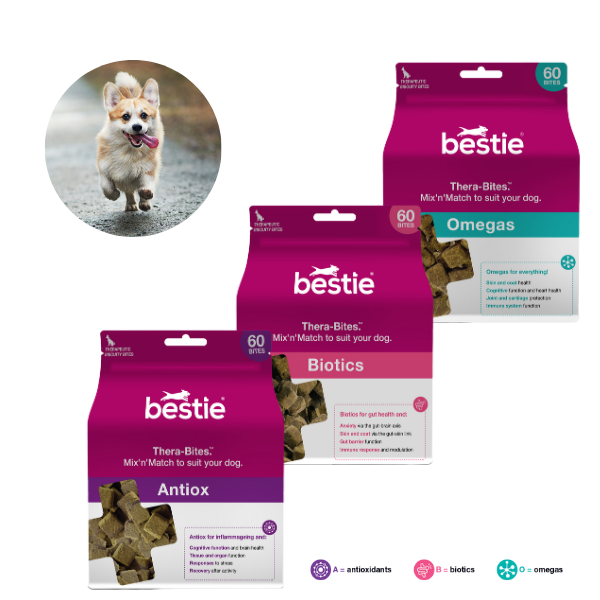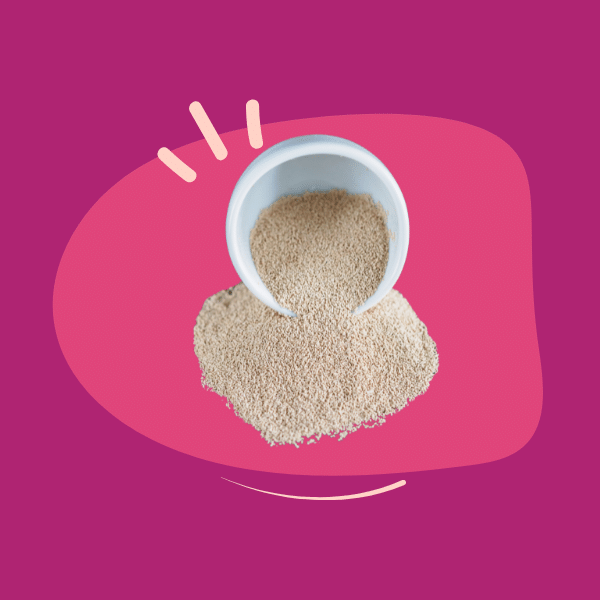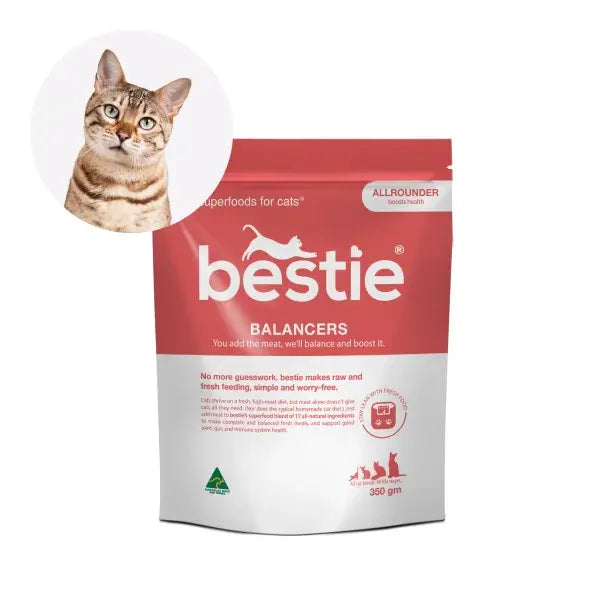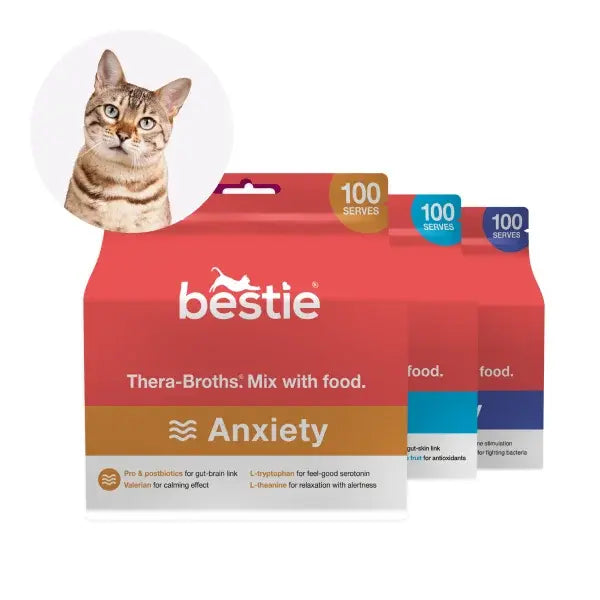In a nutshell:
-
Atopic dermatitis is a major inflammatory skin condition that makes up 50% of all skin allergy diagnoses in dogs.
-
The gut microbiome is made of a core microbial population that maintains intestinal function and communication between the gut-skin axis, keeping your dog's skin healthy.
-
L. rhamnosus and L. paracasei are well-documented probiotic strains with emerging roles in maintaining the skin’s barrier function, helping prevent conditions like allergic and atopic dermatitis.
-
“The AAAH” probiotic & nutraceutical gummy chew provides a multimodal approach to help dogs facing chronic skin irritation.
Your pet’s skin is a reflection of their health, yet nearly 25% of all veterinary visits are the result of dermatological (skin) conditions (Hill et al., 2006). For instance, allergic dermatitis is an inflammatory skin condition that affects 30% of all dogs and tends to be recurrent throughout your pet’s life (Gober et al., 2022).
Since many of these skin conditions are chronic, pet parents find themselves spending a lot of time and money in veterinary clinics each time their dog develops an episode of itchy skin. With veterinarians treating a growing number of dermatology cases, the connections between the gut microbiome and skin health have become more important.
As a result of more research in this area, pet parents can now improve the health of their dog’s skin with targeted probiotics. Using nutrition to address problematic skin, your dog’s itchy skin can be significantly improved, and in some cases, even prevented.
The most common skin disease
Allergic dermatitis is an umbrella term for skin irritations caused by food allergies, contact with environmental irritants, reactions to fleas, and atopic dermatitis. However, almost half of all dogs presenting with skin allergies are eventually diagnosed with atopic dermatitis (Gober et al., 2022).
Atopic dermatitis is a chronic inflammatory skin disease that leads to abnormalities at the surface of the skin (epidermis) and involves the immune system. Often, dogs affected by this condition have a dysfunctional skin barrier that is frequently compromised by pathogens and triggering a hyperactive immune response. Still, atopic dermatitis is more complex than just a case of allergies—there are also genetic and environmental components that lead to atopic flare-ups.
Some of the most popular dog breeds are genetically predisposed to atopic dermatitis, including the boxer, bulldog, Labrador retriever, pug, and West Highland white terrier. In cats, pure breeds appear more at risk of developing skin irritations and atopy-like dermatitis (Hobi et al., 2011).
The typical presentation of atopic dermatitis begins as dry and itchy skin, referred to as pruritis. As the flare-up progresses, the skin becomes more inflamed (erythema), the region begins to darken (hyperpigmentation), and the skin surface tends to thicken (lichenification ). This is extremely irritating for your pet and often progresses to a secondary bacterial infection (Olivry et al., 2014).
(Have a look at this illustration showing typical percentage of affected area, by breed.)
How beneficial bacteria support your dogs’ healthy skin
Bacteria are a normal part of your pet’s environment and diet.
While some bacteria should be avoided, there are many that your dog relies on to support a healthy gut and skin microbiome. This is where the “hygiene theory” comes in.
- The more your pet spends indoors, the less exposure they’ll have to beneficial bacteria found outdoors.
- The more processed food your pet eats, the less they’re exposed to beneficial bacteria in foraged or raw diets.
Together, this limits your pet’s exposure to naturally occurring bacteria found in their environment, sensitising their immune system, and predisposing them to skin conditions like atopic dermatitis. This has been proven in humans, and studies suggest this is also true in cats and dogs (Marsella, 2021).
Using probiotics and the “gut-skin axis” to support your dog’s healthy skin
We introduced the topic of probiotics and the “gut-brain axis” in our previous article (you can read it here if you haven’t already), but let’s have a quick review and build on this.
The gut-brain axis is a communication system between the brain and the trillions of bacteria that live within the digestive system. This bidirectional communication uses neurotransmitters and metabolites produced by gut microbes to transfer information back and forth, allowing for constant communication with the brain. Similarly, we also have a “gut-skin axis”.
Many skin diseases are associated with alterations in the gut microbiome. Since the gut interacts directly with the immune system, imbalances in the gut microbiome can lead to an inappropriate immune response. Several studies have already found skin diseases such as atopic dermatitis, psoriasis, and dandruff to be linked to alterations in the gut-skin axis (De Pessemier et al., 2021).
Alterations in the gut microbiome occur when the “bad” bacteria start to overpopulate the gut and cause disruptions in the gut-skin axis, also known as dysbiosis. These bacteria take advantage of stress, antibiotics, and poor nutrition to promote their growth.
Suddenly, there’s less space for probiotics to colonise and adhere to the cells lining the digestive system. Not only does this affect the gut’s microbial diversity, but it can also lead to a “leaky gut”. This has been well-documented in the case of atopic dermatitis as intestinal permeability becomes compromised, allowing pathogens to leave the intestines and reach the skin where they trigger a strong inflammatory response (Kim & Kim, 2019).
Accumulating data suggests the healthy microbiome of dogs is dominated by a core group of Fusobacterium, Bacteroidetes, and Firmicutes (Pilla & Suchodolski, 2019). Among these bacterial groups, we have a significant population of lactic acid-producing bacteria linked to gut integrity and skin health.

(From: https://www.gastrosav.com/)
Lactobacillus probiotics and healthy skin
Lactic acid-producing bacteria are responsible for converting dietary sugars to lactic acid and metabolic byproducts. This helps with different processes like fermentation within the gut, production of antimicrobial compounds, and supporting proper immune function.
By isolating and culturing the bacterial species found in poop samples of healthy dogs, a recent study found several Lactobacillus species exist within the healthy canine gut microbiome. More importantly, many of these species were found along the entire length of the digestive tract (Jang et al., 2021).
In particular, both L. rhamnosusand L. paracasei are specific probiotic strains with emerging roles in maintaining the skin’s barrier function and helping prevent conditions like atopic dermatitis (Jang et al., 2021).
Lactobacillus rhamnosus
rhamnosus GGwas the first Lactobacillusstrain isolated in humans. It has since received much attention because of its ability to survive and grow in the stomach’s acidic environment, pass through the bile, and adhere to cells lining the intestines. Once these adhesions are formed, L. rhamnosus GG creates a biofilm that protects gut cells and produces different soluble factors that improve the integrity of the digestive system (Capurso, 2019). This strain has now been documented in dogs and is regarded as the “gold standard” when comparing the efficacy of other probiotic strains (Jang et al., 2021).This probiotic supports more than just the gut, extending also to immune function and skin health. Using a validated experimental model, treatment with L. rhamnosus GGalleviated symptoms of atopic dermatitis in dogs genetically predisposed to the skin disease.
In some cases, this probiotic treatment even prevented skin inflammation entirely. The researchers found that dogs supplemented at an early age had decreased levels of allergen mediators (IgE ) circulating in their blood. Not only was L. rhamnosus GG supplementation effective in reducing atopic symptoms during the first six months of life, but these benefits persisted for up to three years after discontinuing probiotic treatment (Marsella et al., 2012).
Lactobacillus paracasei
Paracaseiis another probiotic strain with a promising role in skin health. While this strain has similar attributes to L. rhamnosus GG, recent studies suggest L. paracasei also has an increased ability to promote gut cell longevity compared to L. rhamnosus GG(Jang et al., 2021).What really sets L. paracaseiapart from other probiotics is its steroid-sparing effect. Since atopic dermatitis requires long-term and ongoing treatment with glucocorticoids (steroids), there are often several drug-related side effects that complicate your dog’s health.
Observing 41 dogs with mild-to-moderate cases of atopic dermatitis, 12-week supplementation with L. paracaseidecreased the severity of atopic dermatitis and reduced the use of glucocorticoids and ciclosporin in these patients. In two cases, patients were able to stop treatment with glucocorticoids entirely. This type of reduction is a huge step to efficiently treating atopic dermatitis and improving your dog’s quality of life.
While the exact mechanism of action is under investigation, the steroid-sparing effect of L. paracasei potentially involves the downregulation of IgE through interactions with T helper 1 lymphocytes and associated cytokines like interferon γ (IFN-γ) and interleukin-4 (IL-4) (Ohshima-Terada et al., 2015).
Helping prevent skin conditions using probiotics
The International Task Force for Canine Atopic Dermatitis proposes the using a multi-faceted approach for treating atopic dermatitis that involves different therapeutic targets along the inflammatory pathway.
Keeping probiotic supplementation and healthy skin simple for pet parents, we’ve combined both L. rhamnosusand L. paracaseiinto one easy-to-use gummy chew. Fortunately, these probiotic strains are also resistant to common antibiotics like metronidazole and vancomycin used to treat diarrhea in dogs (Jang et al., 2021). This is especially important for pet owners that use probiotics to treat their dog’s ongoing skin issues, but suddenly need a course of antibiotics to treat diarrhea.
We’ve also gone one step further, adding nutraceuticals to our probiotic blend that have been shown to improve symptoms of atopic dermatitis and inflammatory skin conditions. This way, we can provide a multimodal approach to helping your dog achieve healthy skin.
Here are some of the ingredients we’ve included:
- White Peony (Paeonia lactiflora) to reduce scratching behaviour and skin inflammation (Marchegiani et al., 2020).
- Chinese Liquorice (Glycyrrhiza uralensis) shown to inhibit the HMGB1 signaling cascade and ameliorate the symptoms of AD in mice (Wang et al., 2018).
- Chinese Foxglove (Rhemannia glutinosa) shown to ameliorate psoriatic-like symptoms in mice (Liu et al., 2021).
- Kakadu Plum is an Australian native superfood fruit with the highest recorded levels of natural Vitamin C content in the world. These plums also have high levels of vitamin E and antioxidants.
- Aniseed Myrtle has outstanding antioxidant activity and packed with vitamin E, C, and B9 (folate), as well as magnesium.
- Olive fruitextract rich in polyphenolic compounds that serve as a prebiotic, are antimicrobial, and function as anti-inflammatory compounds.
- A combination of two biologically active macroalgal extracts used to enhance the barrier function of the intestinal mucosa.
We’ve called this nutraceutical gummy chew “The AAAH” and formulated it to keep your dog’s skin happy.
Finally, pet parents and dogs can breathe a sigh of relief.
Ash Sadri

Ash is a Canadian veterinary student studying in Croatia. Before deciding to become a vet, Ash completed his Masters degree at the University Of Western Ontario where he specialized in cancer stem cells research. Since then, he’s been working as a veterinary technician and has special interests in animal nutrition and surgical procedures!
List of references
Capurso, L. (2019). Thirty Years of Lactobacillus rhamnosus GG: A Review. J Clin Gastroenterol, 53 Suppl 1, S1-S41. https://doi.org/10.1097/MCG.0000000000001170
De Pessemier, B., Grine, L., Debaere, M., Maes, A., Paetzold, B., & Callewaert, C. (2021). Gut-Skin Axis: Current Knowledge of the Interrelationship between Microbial Dysbiosis and Skin Conditions. Microorganisms, 9(2). https://doi.org/10.3390/microorganisms9020353
Gober, M., Hillier, A., Vasquez-Hidalgo, M. A., Amodie, D., & Mellencamp, M. A. (2022). Use of Cytopoint in the Allergic Dog. Front Vet Sci, 9, 909776. https://doi.org/10.3389/fvets.2022.909776
Hill, P. B., Lo, A., Eden, C. A., Huntley, S., Morey, V., Ramsey, S., . . . Williams, V. (2006). Survey of the prevalence, diagnosis and treatment of dermatological conditions in small animals in general practice. Vet Rec, 158(16), 533-539. https://doi.org/10.1136/vr.158.16.533
Hobi, S., Linek, M., Marignac, G., Olivry, T., Beco, L., Nett, C., . . . Favrot, C. (2011). Clinical characteristics and causes of pruritus in cats: a multicentre study on feline hypersensitivity-associated dermatoses. Vet Dermatol, 22(5), 406-413. https://doi.org/10.1111/j.1365-3164.2011.00962.x
Jang, H. J., Son, S., Kim, J. A., Jung, M. Y., Choi, Y. J., Kim, D. H., . . . Kim, Y. (2021). Characterization and Functional Test of Canine Probiotics. Front Microbiol, 12, 625562. https://doi.org/10.3389/fmicb.2021.625562
Kim, J. E., & Kim, H. S. (2019). Microbiome of the Skin and Gut in Atopic Dermatitis (AD): Understanding the Pathophysiology and Finding Novel Management Strategies. J Clin Med, 8(4). https://doi.org/10.3390/jcm8040444
Liu, A., Zhang, B., Zhao, W., Tu, Y., Wang, Q., & Li, J. (2021). Catalpol ameliorates psoriasis-like phenotypes via SIRT1 mediated suppression of NF-κB and MAPKs signaling pathways. Bioengineered, 12(1), 183-195. https://doi.org/10.1080/21655979.2020.1863015
Marchegiani, A., Fruganti, A., Spaterna, A., Dalle Vedove, E., Bachetti, B., Massimini, M., . . . Cerquetella, M. (2020). Impact of Nutritional Supplementation on Canine Dermatological Disorders. Vet Sci, 7(2). https://doi.org/10.3390/vetsci7020038
Marsella, R. (2021). Atopic Dermatitis in Domestic Animals: What Our Current Understanding Is and How This Applies to Clinical Practice. Vet Sci, 8(7). https://doi.org/10.3390/vetsci8070124
Marsella, R., Santoro, D., & Ahrens, K. (2012). Early exposure to probiotics in a canine model of atopic dermatitis has long-term clinical and immunological effects. Vet Immunol Immunopathol, 146(2), 185-189. https://doi.org/10.1016/j.vetimm.2012.02.013
Ohshima-Terada, Y., Higuchi, Y., Kumagai, T., Hagihara, A., & Nagata, M. (2015). Complementary effect of oral administration of Lactobacillus paracasei K71 on canine atopic dermatitis. Vet Dermatol, 26(5), 350-353, e374-355. https://doi.org/10.1111/vde.12224
Olivry, T., Saridomichelakis, M., Nuttall, T., Bensignor, E., Griffin, C. E., Hill, P. B., & (ICADA), I. C. o. A. D. o. A. (2014). Validation of the Canine Atopic Dermatitis Extent and Severity Index (CADESI)-4, a simplified severity scale for assessing skin lesions of atopic dermatitis in dogs. Vet Dermatol, 25(2), 77-85, e25. https://doi.org/10.1111/vde.12107
Pilla, R., & Suchodolski, J. S. (2019). The Role of the Canine Gut Microbiome and Metabolome in Health and Gastrointestinal Disease. Front Vet Sci, 6, 498. https://doi.org/10.3389/fvets.2019.00498
Wang, Y., Zhang, Y., Peng, G., & Han, X. (2018). Glycyrrhizin ameliorates atopic dermatitis-like symptoms through inhibition of HMGB1. Int Immunopharmacol, 60, 9-17. https://doi.org/10.1016/j.intimp.2018.04.029


















